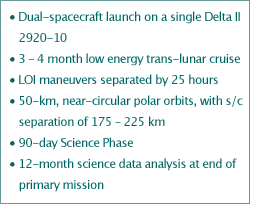 | ||
  |
||
|
About GRAIL
The Gravity Recovery and Interior Laboratory, or GRAIL, mission is a part of NASA's Discovery Program. It is scheduled to launch in 2011. GRAIL will fly twin spacecraft in tandem orbits around the moon for several months to measure its gravity field in unprecedented detail. The mission also will answer longstanding questions about Earth's moon and provide scientists a better understanding of how Earth and other rocky planets in the solar system formed.
 Scientists will use the gravity field information from the two satellites to X-ray the moon from crust to core to reveal the moon's subsurface structures and, indirectly, its thermal history. Scientists will use the gravity field information from the two satellites to X-ray the moon from crust to core to reveal the moon's subsurface structures and, indirectly, its thermal history.
The measurement technique that GRAIL will use was pioneered by the joint U.S.-German Earth observing Gravity Recovery and Climate Experiment, or GRACE, mission launched in 2002. The GRACE satellites measure gravity changes related to the movement of mass within Earth, such as the melting of ice at the poles and changes in ocean circulation. As with GRACE, both GRAIL spacecraft will be launched on a single launch vehicle.  GRAIL's principal investigator is Maria
Zuber of the Massachusetts Institute of Technology in Cambridge. Zuber's team
of expert scientists and engineers includes former NASA astronaut Sally Ride,
who will lead the mission's public outreach efforts. Up to five cameras aboard
each spacecraft will allow students and the public to participate in GRAIL’s
mission of lunar exploration. Each GRAIL spacecraft will carry the cameras to
document their views from lunar orbits. GRAIL's principal investigator is Maria
Zuber of the Massachusetts Institute of Technology in Cambridge. Zuber's team
of expert scientists and engineers includes former NASA astronaut Sally Ride,
who will lead the mission's public outreach efforts. Up to five cameras aboard
each spacecraft will allow students and the public to participate in GRAIL’s
mission of lunar exploration. Each GRAIL spacecraft will carry the cameras to
document their views from lunar orbits.GRAIL will support NASA's exploration goals as the agency plans to returns humans to the Moon. In 2008, the agency will launch the Lunar Reconnaissance Orbiter, or LRO, to circle the Moon for at least a year and take measurements to identify future robotic and human landing sites. The orbiter also will look for potential lunar resources and document aspects of the lunar radiation environment. After a 30-year hiatus, LRO represents NASA's first step toward returning humans to the Moon. GRAIL’s high-resolution gravity measurements will complement LRO’s high-resolution observations of the lunar surface.  "As NASA moves forward with exploration endeavors, our lunar science missions will be the light buoy leading the path for future human activities," said Jim Green, director of the Planetary Division, Science Mission Directorate, Washington. |
||
 |
||
This web site is funded through a research
grant from NASA to Maria Zuber.
Site design, construction, and maintainence by R.S. Hildebrand. Contents
Copyright © 2008 | ||